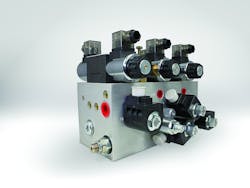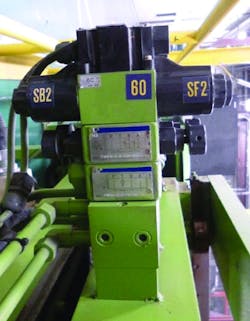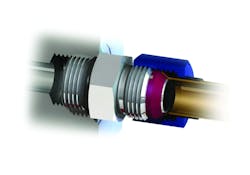Hydraulic systems are often considered major perennial consumers of oil and, in turn, replacement fluid becomes an inherent cost of operating hydraulic equipment. But if you’re serious about getting your hydraulic equipment running reliably and lean, you ought to make sure it doesn’t “leak” money.
According to the National Oceanic and Atmospheric Administration (NOAA), more than 700 million gal (2.65 billion liters!) of petroleum products enter the environment each year. Around half of this volume comes from irresponsible and illegal disposal. Hydraulics’ contribution, according to hose manufacturer Gates, is 98 million gal (370 million liters). That represents how much oil leaks from hydraulic equipment each year. These are staggering statistics, especially when the NOAA states that as little as one liter of oil can pollute up to one million liters of water.
With the above in mind, a question quickly pops up: How much hydraulic oil does each of your machines consume in a year? The only way you can know for sure, particularly if more than one machine is under your watch, is if you measure and record all top-offs. It’s near impossible to control or manage anything, though, so those measurements likely don’t happen.
In my experience, such is the case with most hydraulic-equipment users. However, when clients have done so at my urging, they’re often unpleasantly surprised at how much oil a particular machine actually loses over a year.
Addressing the Elephant
The downtime required to fix leaks is almost always “the elephant in the room.” That typically means the leakage rate is allowed to increase to the point where the cost of the required volume of replacement oil justifies the necessary downtime and repair costs.
Related
Stop High-Pressure Leaks with Flange Fittings
How Little Leaks Keep Hydraulic Equipment Users Poor
Is YOUR Hydraulic Machine A 'Leaker'?
For example, a past client carried out a survey to determine the source of a large number of hydraulic leaks at its plant, and calculated repair cost to be $28,000. Management was horrified when confronted with this figure—until it was revealed that the plant’s hydraulic oil consumption amounted to three drums per week, at a cost of about $450 per drum ($1,350 per week). This meant the payback period on the cost to fix the leaks was less than five months.
This is an oversimplification of the real cost, though. In addition to the oil, there are the costs associated with clean-up, proper disposal, and the potential safety risks posed by a leaky machine. Plus, in places where oil can get out, contamination can make its way in. On top of that, you’re reminded each time you buy a filter element that it costs money to remove contaminants—and much more if you don’t.
How To Eliminate Leaks
As already acknowledged, the downtime required to fix leaks can be an issue. But this is often just used as an excuse for laziness. And these days, there are a number of ways to eliminate leaks.
Engineer Them Out — If a hydraulic system doesn’t have connectors, they can’t leak. Sure, a system must have some connectors, but the number can be significantly reduced through intelligent use of manifolds, cartridge valves, and stack valves, known collectively as integrated hydraulic circuits (IHCs) (Figs. 1 and 2).
The application of this technology normally falls within the realm of the machine designer. However, if your machines feature line-mounted valves with many connections, then replacing these line-mounted valves with one or more IHCs will simplify the plumbing and greatly reduce the number of potential leakage points.
Use Reliable Connectors — Tapered-thread connectors like NPT and BSPT are the least-reliable type of connector for high-pressure hydraulic systems because the thread itself provides a leak path. The threads are deformed when tightened and, as a result, any subsequent loosening or tightening of the connection increases the potential for leaks.
Connectors that incorporate an elastomeric seal, such as a UN-O-ring, BSPP, ORFS, and SAE 4-bolt flange, offer far superior seal reliability. Thus, for leak-free reliability, it’s best to replace pipe-thread connectors with a type that incorporates an elastomeric seal, where possible.
That said, the world’s most commonly used hydraulic connection, the JIC 37 flare, relies on a metal-to-metal seal. What that means is it doesn’t always achieve a permanent, leak-free joint, particularly in the case of tube-end connections. However, installing a conical washer between the joint’s nose and flare can eliminate leaking flare joints.
One type of flare seal, manufactured by Flaretite, comprises a stainless-steel stamping with concentric ribs that contain pre-applied Loctite sealant (Fig. 3). When tightened, the ribs crush between the two faces of the joint, eliminating any misalignment and surface imperfections. The combination of the crush on the ribs and the sealant ensure that a leak-free joint is achieved.
Tighten Them Correctly — A common cause of leaks from 37° flare joints and compression-type tube fittings is incorrect torque. In the case of flare joints, insufficient torque results in inadequate seat contact, while excessive torque can result in damage to the tube and connector through cold working. In the case of compression joints, incorrect torque can result in too much or too little “crush” on the ferrule. For optimum sealing reliability, consult the connector manufacturer’s torque recommendations and apply them as directed.
Eliminate Vibration — Vibration can stress hydraulic conductors, cause fatigue, and affect connector torque. If vibration is apparent, the root cause must be addressed. This may involve the installation of hoses and/or rubber mounting blocks to eliminate vibration “bridges” between the hydraulic power unit, reservoir, and valves. Also, always ensure all conductors, especially pipes and tubes, are adequately supported with sufficient clamps. This issue is important enough to warrant mention in the relevant standards: ISO 4413, ANSI-NFPA-JIC T2.24, AS 2671, etc. The table lists the recommended maximum distance between conductor supports based on tube/pipe diameter.
Keep The Machine Cool — Having outlined the benefits of hydraulic connectors that incorporate an elastomeric seal, it’s important to note that their reliability is contingent on hydraulic-fluid temperature being maintained within acceptable limits. When operating oil temperatures above 85° C (185° F), service life of most seal compounds reduces exponentially. Moreover, a single over-temperature event of sufficient magnitude can damage all of the seals in a hydraulic system, resulting in numerous leaks. This is a further reminder that a hot-running hydraulic machine is an unreliable hydraulic machine.
Brendan Casey is the founder of HydraulicSupermarket.com and author of Insider Secrets to Hydraulics, Preventing Hydraulic Failures, The Hydraulic Troubleshooting Handbook, Hydraulics Made Easy, Advanced Hydraulic Control and The Definitive Guide to Hydraulic Troubleshooting. A hydraulics specialist with an MBA, he has more than 25 years of experience in the design, maintenance. and repair of mobile and industrial hydraulic equipment. Visit his website at www.HydraulicSupermarket.com
About the Author
Brendan Casey
Founder and author
Brendan Casey is the founder of HydraulicSupermarket.com and an author of several hydraulic maintenance and troubleshooting books. A hydraulics specialist with an MBA, he has more than 20 years experience in the design, maintenance and repair of mobile and industrial hydraulic equipment. Visit his website, www.hydraulicsupermarket.com, for more information.

Leaders relevant to this article:



